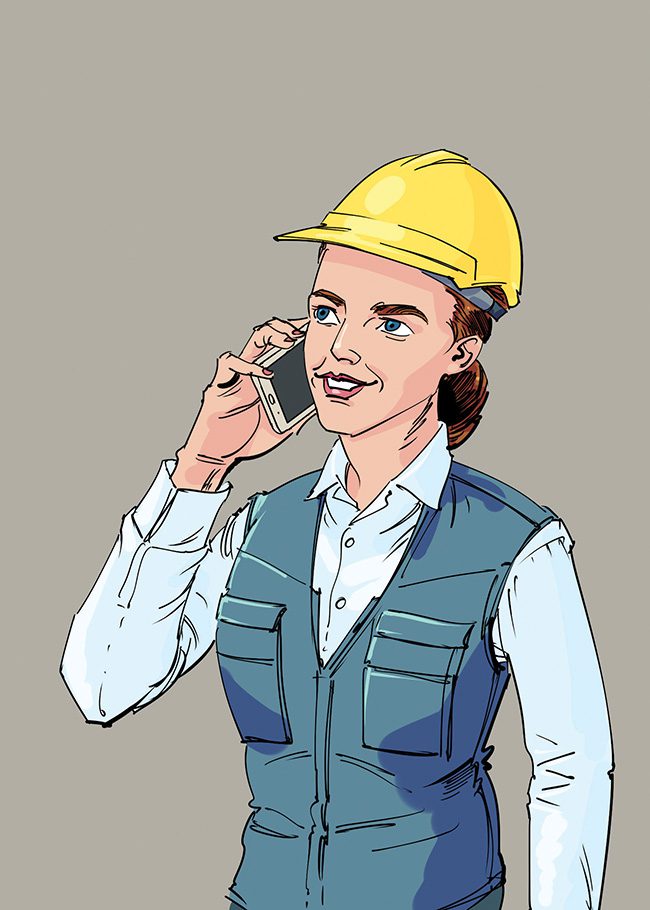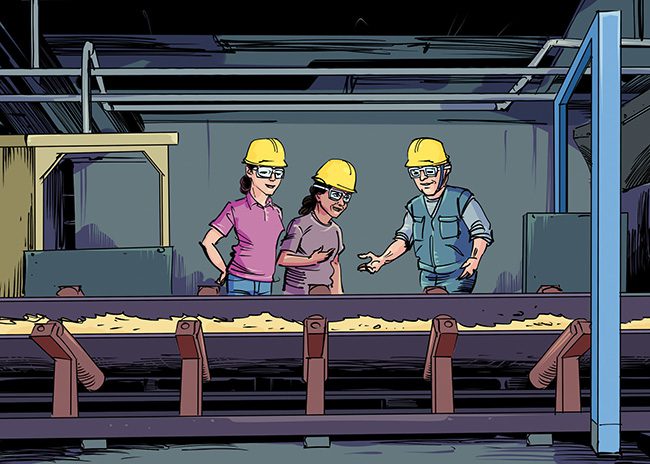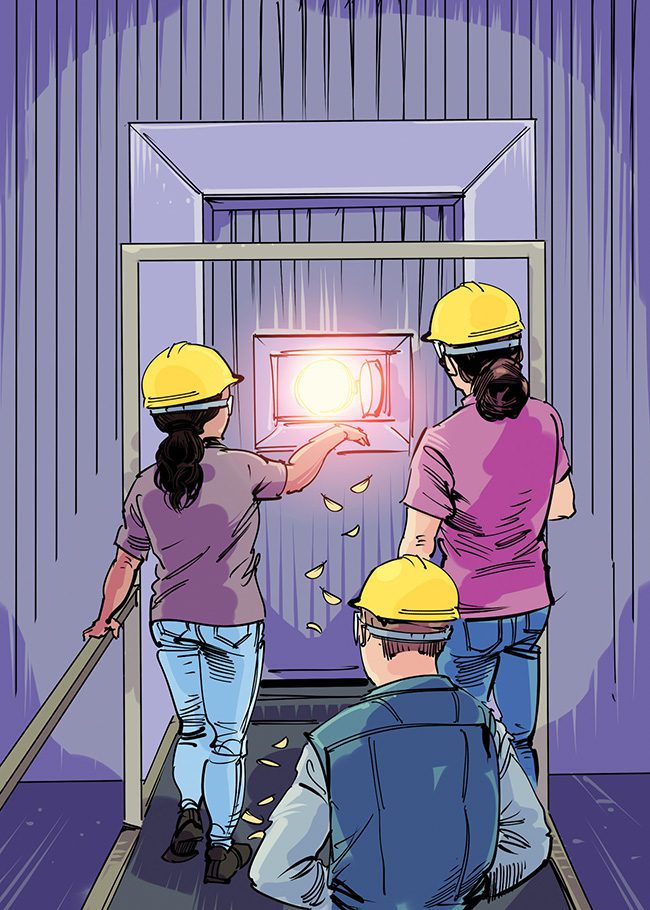Marnie Surfaceblow: What Is Killing This Biomass Boiler? Marnie and Maya Are on the Case!
Long-time POWER readers may remember Marmaduke Surfaceblow, a fictional character whose engineering escapades were brilliantly portrayed in hundreds of stories published within POWER magazine’s pages over more than 30 years beginning in 1948. Today, the fictional series continues through Marmy’s granddaughter, Marnie, who is an engineering wiz in her own right.
When seeking answers to critical operations problems, consider that multiple root causes may be at play—thus requiring many different solutions. Watch as our heroines track down the culprits!
As they trudged through the sultry heat of an early July morning toward the plant engineering office, Marnie Surfaceblow, vice president and lead field engineer of Surfaceblow & Associates International (Figure 1), finally had to say something. “Maya, my able assistant, this smell is transcendently terrible! It’s absolutely appalling! It’s a malodorous and mephitic miasma of …”
 |
|
1. Marnie Surfaceblow, vice president and lead field engineer of Surfaceblow & Associates International. Source: POWER |
“Amazing alliteration as always, ma’am. But kindly be respectful; the plant workers dispose of poultry waste products properly, providing power with renewable energy. We will persevere.”
Breathing through the crude albeit expensive filter of a Louis Vuitton scarf, Marnie cast a side look at her assistant with the hint of a smile. “Point taken. But still, it’s like that last kraft paper mill we worked at! It took weeks to get the smell out of my hair. I should have worn a HAZMAT suit.”
As they approached the guard shack, Maya Sharma, Marnie’s senior field engineer, joked, “Perhaps I shall gift you a bespoke HAZMAT suit? I have memory you said the color of this year is something named ‘Very Peri.’ Is that right?”
Astonished, Marnie replied, “Your memory amazes me. I don’t remember saying that … it sounds like me … maybe after we get paid. Anyhow, here comes our client so let’s get into character. Luke! It’s so good to see you again!” Marnie walked forward and shook the hand of Luke Broussard, the plant manager of a little Louisiana bio-energy plant with a big problem.
“Well, if it ain’t Miss Surfaceblow! It’s good to see your face again, although the last time you were still goin’ to school and tagging along with your grandpa Marmaduke.”
“It was supposed to be summer vacation, but grandpa thought vacation meant ‘we’ll only work forty hours a week,’ ” muttered Marnie. She introduced Maya to Luke. He shook her hand and said, “I understand this is your first time in Louisiana Miss Sharma. I gotta warn you, it gets mighty hot and humid!”
“You should visit Mumbai. This is quite nice, relatively.”
“Well, that may be, but we also got hurricanes here!” replied Luke.
“We call ours ‘cyclones,’ ” Maya retorted.
“OK, well, then watch out for the gators hereabouts,” Luke warned, arms folded. Maya took a similar stance, replying, “We have crocodiles. Five meters long.”
Marnie finally broke up the brag fest by saying, “OK you two, you can brag about hurricanes and crocodiles later. Let’s get inside and talk turkey—I mean chicken.”
Waste to Energy
“We were designed to burn sugar cane waste from nearby mills. That’s worked really fine for us since, well, your grandpa fixed that problem with our traveling grate. ‘Bout three years ago, this giant poultry plant opened up down the road. They asked if we’d buy their waste for fuel. Being a stoker furnace, we could burn it, but didn’t see why we should change. Then, a year later, they offered us $5 a ton to take it off their hands. We ran the numbers and it looked good.”
“Really?!? Why’d they suddenly start paying you to take the waste?” Marnie asked suspiciously.
Luke grinned. “The local landfill said the smell was so awful that even the folks at the sewage plant next door complained about it—and you better believe those folks got cast-iron noses,” he said. Maya ignored Marnie’s smug look cast her way.
Luke continued: “Things were OK mixing the fuels up to ‘bout a 50-50 blend. Then, we’d start to slag the boiler near the arch, block off the generation tubes, and finally the furnace ran positive pressure and we’d trip. Then, we’d spend two or three weeks cleaning the boiler out and start up again at something safe, like 20% poultry waste, then creeping back up. It weren’t so bad. We’d come down once every 6 months or so for cleaning. Then, after our last outage, something changed.”
“What was special about this outage?” Marnie asked, as Maya tapped notes into her phone with efficient dexterity.
“Don’t know. Just the normal—cleaning the grate, de-slagging the boiler, replaced a leaky drain valve on our #4 heater. The hardest part was all the fuel yard work.”
Marnie’s interest was suddenly piqued, as Luke continued. “The state said we had a runoff problem from the poultry pile. So, now we got 20,000 tons of poultry waste in a fuel barn, and boy oh boy does it concentrate the smell.” Maya ignored Marnie’s second smug look. “But, then, the poultry plant changed something, I don’t know, and now we can’t burn more than 10% of the stuff. We also tried taking waste from a smaller farm up yonder. Made no difference.”
“Tell me about your furnace cleaning. How well does that work?” asked Marnie.
“Oh, we keep up on that. In fact, we just upgraded the sootblowers by the arch, and it only buys us about another month of operations. We thought about upping our blower pressure, but we’re already eroding the tubes away as it is.”
“And more thermal shock doesn’t help either. Have you tried any fuel additives?”
“I was about to come to that,” Luke replied. “We started with magnesium oxide, and then kaolin clay. They help a little, but they’re expensive.”
“Sir, did you have ash mineral and fusion temperature analyses from before and after the outage?” asked Maya.
“Oh, we haven’t run those for years. They’re kinda expensive.” Maya’s shocked, silent look spoke volumes. “But on the plus side, we do furnace tuning every six months,” offered Luke, feeling a little embarrassed under Maya’s gaze. “We got two air fans and one induced draft fan for the furnace, and the tuners are always having to rebalance pressures.”
“Sir, what does your DCS system say about furnace pressures?” Maya asked hesitantly, unsurprised by Luke’s reply. “We don’t have any working furnace pressure sensors ‘cept after the economizer. Our fans all get damper problems from the humidity. Sometimes, we even get Spanish moss blocking the intakes.”
Marnie grabbed her hard hat. “This all sounds simply dreadful, Luke. You have more problems than we had opossums living in our motel room last night. Oh yeah, how many did you find sleeping in your bathroom, Maya?”
“Honestly ma’am, I did not count. One was more than sufficient. And they have many, many teeth.”
“Well, at least they eat ticks, right?” Marnie beamed happily as Maya shuddered. “Luke, why don’t you give us the grand tour.”
Fuel for the Fire
“Here’s where our poultry waste pile was, and right over yonder is our new fuel barn.” Luke narrated as they surveyed a desolate lot near the wood chip pile. Feathers, straw, and other remnants were mixed into an off-white mudscape. Maya leaned to whisper to Marnie, staring at the ground. “Ma’am … I have … seen this before!”
“Ooooooo … do that again, Maya!” Marnie replied, bouncing with unusual joy.
“Do what again ma’am?” Maya asked with a puzzled look.
“Whisper like you’re in a horror movie—all creepy and mysterious.”
Maya rolled her eyes. “Seriously, ma’am, my Auntie Komal had a farm in Nagpur and there were many chicken coops on the farm. The waste made white stains on the ground and nothing would ever grow there.”
“You’re on the right track,” Marnie replied cheerfully, “but there’s more to see. Luke, take us to the fuel feed system.” As Luke and Marnie headed toward the conveyers, Maya stealthily grabbed a handful of chicken feathers and stuffed them into the pocket of her coveralls.
Applying Additives
“We dump the fuel additive on the main belt after the wood chip and poultry waste conveyors meet at the mixing bin upstream. We use variable-speed motors on the volumetric feeders for blend control. The additive drops onto the belt right here,” Luke said, as he pointed to a row of spray nozzles coating the top of the fuel on the moving conveyor with a thick off-white slurry (Figure 2). “And, then, it goes to screw feeders and spreads out on the grate.”
 |
|
2. Marnie, Maya, and Luke inspect the fuel on the conveyor belt downstream from the additive spray system. Source: POWER |
“Hmmm …,” Marnie trailed off as she watched the mixed biomass flow by. “So, you dump it all right here, just before it goes into the day bin and then to the screw feeder? And this is kaolin clay slurry you’re spraying right now, am I right?”
“Yes ma’am, about eight to 10 tons a day.”
“See the problem?” Marnie asked Maya, and was rewarded with a nod from her assistant. “Good. Luke, can you show us how to get to the inspection ports on the furnace west side? It’s time to question the next suspect.” Luke raised an eyebrow at the idiom and led the way into the boiler structure.
Furnace Draft
Luke held the superheater inspection port open while Marnie and Maya peered through a welder’s mask at the fiery orange furnace. “Just how bad is the temperature and air stratification?” asked Marnie.
Luke shrugged. “Well, it don’t seem too bad until we slag up. The boiler’s really clean right now from last week’s outage, and it seems pretty balanced.” Without notice, Maya pulled some chicken feathers from her pocket and tossed them into the air in front of the inspection port (Figure 3). The furnace suction lazily drew most of them in, while others fluttered to the steel grate flooring. Turning to face astonished looks from Marnie and Luke, Maya asked, “May we walk to the other side of the furnace please?”
 |
|
3. Maya conducts an impromptu test of furnace draft with a handful of feathers as Marnie and Luke look on. Source: POWER |
Just two minutes later, as Luke held open the east-side inspection port, Maya grabbed another handful of feathers from her pocket and tossed them into the air, except this time they shot like arrows into the furnace. Marnie nodded with proud satisfaction toward her assistant. “I’ve seen enough. Let’s have a plant meeting. I know it’s so hot I’m losing a dress size every hour, but I need a quart or two of coffee.”
Culprits Exposed
Marnie addressed the engineers and operators gathered in the control room. “Let’s play detective. When finding the killer—the culprit choking your boiler to death with slag—one has many suspects. Most are false leads, like when you catch a glimpse of the chamber maid having gang tattoos on her arms while serving high tea.”
The crowd shifted and muttered. “Maids and tattoos? Did the heat get to her?” Luke whispered to Maya. “Please sir, indulge her, she is, as you say, ‘on a roll.’ ”
Marnie continued: “The detective discovers she must eliminate each suspect in turn until she catches the culprit. But this mystery is more like the Agatha Christie novel Murder on the Orient Express, where detective Hercule Poirot discovered, instead of one killer, there were many killers!” Marnie raised her giant mug of coffee with a dramatic flourish. The plant staff cast side-eyes toward Luke.
“Maya, reveal the first culprit!” Marnie exclaimed with a grin. Playing along, Maya explained. “The first is your storage of poultry waste. Poultry waste contains potassium and sodium salts that cause significant slagging, but most of them are water-soluble. When piled outside, your frequent rains washed much of them out of your fuel. We saw the white stains on the ground like at my Auntie Komal’s farm. Now, the fuel is covered and more salt enters your boiler.”
Marnie retook the stage. “I’m guessing some of you already suspected this, and that’s why you’re experimenting with fuel additives, but here we have a gang of culprits working against you. First, you’re spraying the additives on top of such a high-moisture fuel that it doesn’t saturate it. Second, you’re spraying after the last mixing point, so the fuels and additive won’t have an even distribution. Finally, you are using volumetric feeders on a very sticky fuel with highly variable moisture—I’ll bet a steak dinner that your fuel feed accuracy isn’t within +/- 20%.” Heads began to nod around the control room.
Maya blurted out, “Or, ma’am, they could place the additive directly onto the poultry waste belt before the mixing bin, so it helps the more problematic fuel and has greater opportunity to mix.” Marnie started with realization she’s been trumped by her assistant, dramatically bowed towards Maya. “Or … you could try what Ms. Sharma just suggested.” Silently, Marnie mouthed, “Well done!”
Emboldened by the honest respect from her boss, Maya addressed the room with confidence. “There is one final culprit killing your boiler! You say there is air flow stratification but cannot determine the severity. You believe it is from slag blockage, but say your boiler is clean right now. Yet, when I tossed some chicken feathers into the air near the inspection ports, there was clearly much greater negative pressure on the east side. With more flue gas flowing on the east, the boiler is not balanced, temperatures are certainly higher, and thus unbalanced slag accumulation happens.”
“Precisely!” Marnie dramatically annunciated. “Just like in the Orient Express—multiple killers, not just one! Now, let’s go to lunch, and then start working on how we stop each of these culprits from committing their dastardly deeds!”
Luke looked at the floor and shook his head in amazement. “You’re just like your grandpa, ma’am. That was a right fine piece of, I guess you’d say, detective work? He’d have been proud of you. And, Miss Sharma, with your brains I can see why Marnie picked you to work with her. You’re right, let’s break for lunch. I know a fine Cajun diner we need to save from having too much food, and don’t worry Miss Sharma, they have the best veggie dishes you’ve ever tasted.” The meeting broke up as the plant staff started planning for a busy afternoon.
As the crew left the control room, the shift supervisor turned in his chair and asked the lead operator, “What’d you think about what Miss Surfaceblow said, Skeeter?”
The lead operator shrugged. “Well, Zeke, I reckon when it comes to Christie, I’m more a Miss Marple fan than I am of Poirot, and that there poultry waste was nearly our boiler’s Nemesis!” Zeke nodded emphatically in agreement.
—Una Nowling, PE is an adjunct professor of mechanical engineering at the University of Missouri-Kansas City.